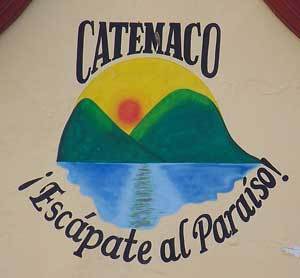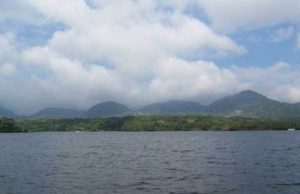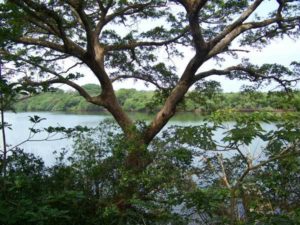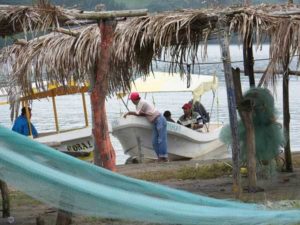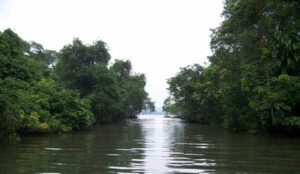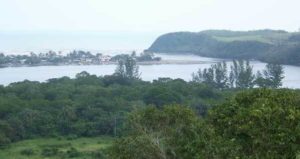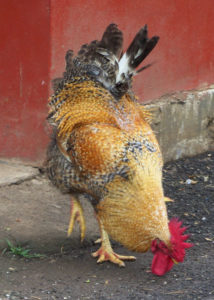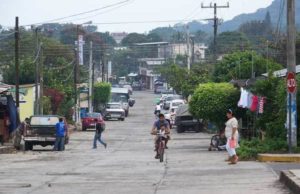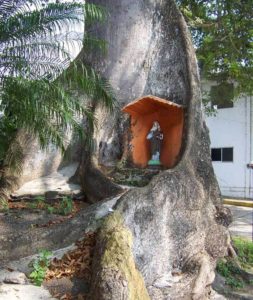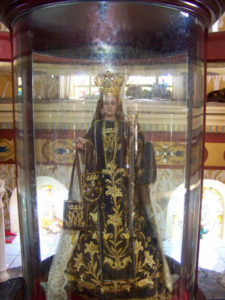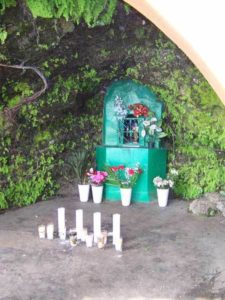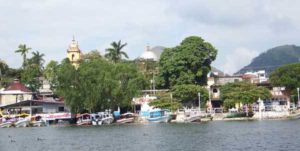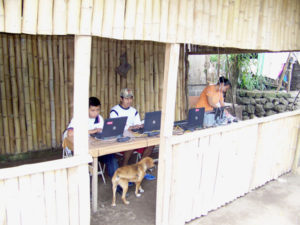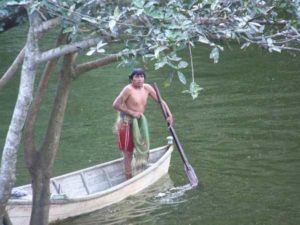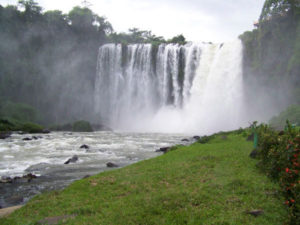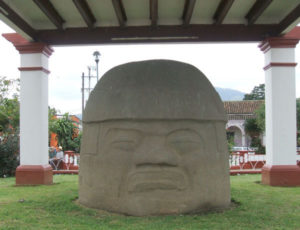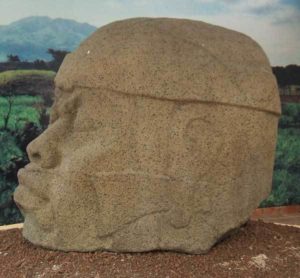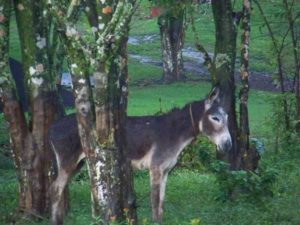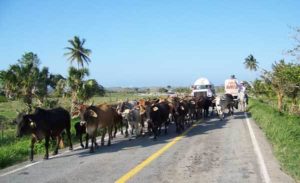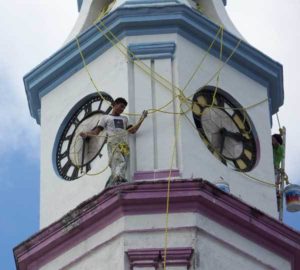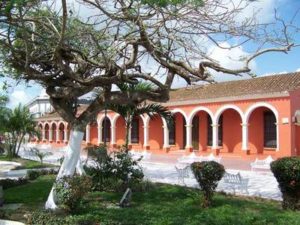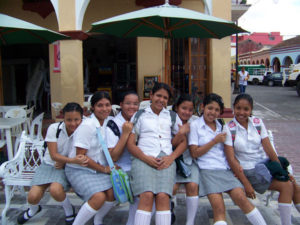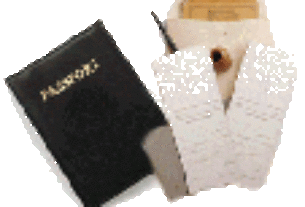The arch at the entrance to the city of Catemaco says “Escape to Paradise!” Catemaco is both a town and a lake in the region known as Los Tuxtlas, in southern Veracruz state. The area is very green and wet, much of it covered by jungle. The Gulf of Mexico is nearby, and the area includes a biosphere preserve. The region is known for ecotourism.
The town of Catemaco has about 25,000 residents. The side streets are very tranquil, with pedestrians outnumbering cars, mopeds, and bicycles. There are few cars parked on the street. The people are very friendly and helpful, and the vendors are not aggressive. The area is relatively poor, and it seems that every fourth house has a mini-business of some kind or other. My favorite mini-business was the nearby Internet cafe, in an open air bamboo lean-to.
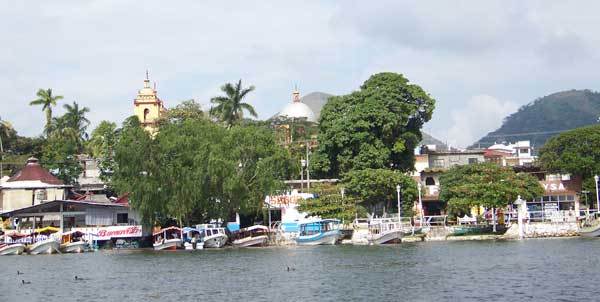
Mexican tourism is a major industry in Catemaco; we rarely saw Americans, Canadians, or Europeans on the streets. We used the Lonely Planet guidebook; some guidebooks do not mention this area. English is not widely spoken, although many people like to use the few words of English they know, learned during a stint working in the USA. Most Americans have never heard of Catemaco, but Mexicans jokingly ask if you are going there for a ritual cleansing. Catemaco is the site of an annual witchcraft gathering on the first Friday in March.
The town plaza is just above the lake, and is dominated by the Basilica. The street and sidewalk along the lake are called the Malecon. The Malecon is lined with restaurants, hotels, shops, and lanchas offering tours of the lake.
Getting there and around
The most practical way to reach Catemaco by air is to fly to Veracruz City, and then take the bus to Catemaco. The first class bus ride on ADO is 3.5 hours, and costs around 10 dollars US. The ride is comfortable; the bus makes a few stops along the way, and then drops you at the station on the east end of the Malecon. ADO also offers service to Acayucan and Minatitlan, for those headed for the Yucatan and points east of Catemaco. For those with more stamina, one can take an eight hour ADO bus ride from Mexico City.
Buses run frequently from Catemaco to San Andres Tuxtla and Santiago Tuxtla, and then on to Veracruz. In addition to buses leaving from the ADO station, there is a second class bus station at the west end of town, near the entrance to the city. Many of the second class buses are very good, like first class buses without TVs or bathrooms.
There are colectivos, little pickup trucks, going to the surrounding rural areas. The colectivos are known as “piratas,” and seat five passengers in the cab, and more on wooden benches in the bed of the truck. The piratas for Sontecomapan and points east and north leave from a parking lot a few blocks north of the ADO station. The piratas going around the west side of the lake leave from the street a couple of blocks above the west end of the Malecon.
In hindsight, perhaps we should have rented a car or Jeep to enable us to visit the various sites in the area; this would have been more convenient, and would have enabled us to see more. But you can see almost everything in the area using public transportation; it just requires more effort and time.
Shopping
As in most Mexican towns, there are shops conveniently located on every block. Perhaps the largest Supermarket in Catemaco is the Rodeo, at the only traffic light in town. The San Miguel butcher shop, just down the street from the Rodeo, has roasted chicken, with all the fixings, for less than $4 USD. The traditional market is located just west of the central plaza, a couple of blocks above the Malecon. Our motto for the trip became “When you see what you want, buy it.” We would go by a street stand or store, see something that we were interested in, only to find the store or stand closed when we returned. It is best to shop in the morning, when the choices are better and all the shops are open.
For major shopping trips, we went to San Andres for the Soriana or the Bodega (Walmart), both on the main highway, easy to reach by second class bus. We prefer the Bodega, which is closer, cleaner and has better service.
Hotels
As a tourist town, Catemaco is full of hotels of all price ranges. The high season is Christmas and Easter, with lower prices the rest of the year. In some cases, the rates are lower midweek than weekends.
La Finca is perhaps the nicest hotel. It is a turquoise building on the lake, a five minute walk west of town, on the other side of the river. The grounds are well manicured, with rooms with a view of the lake. Rooms for two cost around 80 to 120 USD per night.
The Hotel Playa Cristal is on the town side of the Malecon, on the west side of town. Like the other hotels in town, it has no grounds to speak of, but looks very nice. Rooms for two cost 60 to 100 USD per night.
The Hotel del Lago is on the town side of the Malecon, not far from the center of town. Rooms for two cost 40 to 55 USD per night.
The Hotel Los Arcos is closer to the center of town, and hence noisier. Rooms for two cost 50 to 75 USd per night.
The Hotel Posada Koniapan is on the east side of town. Unlike most hotels in town, they have a nice garden. Rooms for two cost 45 to 60 USd per night.
We stayed at Villas Tepetapan and RV park. The grounds are beautiful, with excellent birdwatching, on the Rio Grande de Catemaco. The Villas are generally rented by the month. The RV park has 30 amp service, water, sewer, and security
Restaurants
There are restaurants all over town, most informal and inexpensive. There are some better restaurants on the Malecon, such as La Ola and Jorge’s. The restaurants on the Malecon were large, but almost empty. I was told that they are sized to handle bus groups of Mexican tourists. We were assured that the restaurant Las Changadas, on the west end of the Malecon, served good hamburgers.
Attractions
Lake Catemaco is about six miles (ten km) across, and includes a few islands. The lake was formed as a result of a lava flow. One of the islands is famous for its population of Macaque monkeys. Boat tours in lanchas are a tourist staple, with an obligatory stop to see the monkeys. The usual tour costs 350 pesos per a group of 1 to 6 people, or 50 pesos per person for larger groups. Most tours include a stop at El Tegal, where the Virgin of Carmen was seen, and Nanciyaga, the eco-resort. We would have preferred not to have seen the monkeys, like a bad zoo, but we always enjoy being on the water, and we saw one spectacular bird that we had never seen. Ask for a boat with a four cycle engine, “cuatro tiempos”, instead of the old smelly two-stroke motors. Compare the offerings before you pick one, asking how long, and which stops are included. The usual tour is one hour and 15 minutes, but you can ask for a longer tour if you like, just besure you know what it will cost. There are many lanchas, so if you don’t like the tour, pilot, or motor, just walk down the Malecon and talk to somebody else.
The Basilica de la Virgin del Carmen is quite beautiful inside, decorated with geometric and floral designs. The current church was constructed in the 1950s, in a style that appears much older. The statue of the Virgin is above and behind the altar, with stairways leading to the statue. The Virgin Mary, according to popular belief, appeared to a fisherman in 1664, and left the statue behind as a sign. Pilgrims of all ages and economic levels come to the Basilica, bearing fresh flowers. The practice is to take the flowers, make the sign of the cross on the glass surrounding the statue, and rub the flowers over one’s body. The ritual is believed to be a mix of Pre-Hispanic beliefs and Christianity. A pilgrim told me that the statue is miraculous; people make requests in their heart, tell no one, and then have patience and see what happens. The feast of the Virgin del Carmen is the 16th of July, and is commemorated in Catemaco with processions and bus loads of pilgrims. The Basilica is located on the main square in Catemaco.
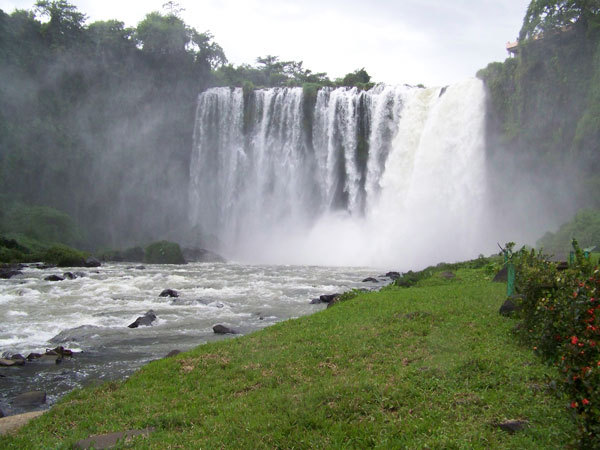
The Salto de Eyipantla is a huge and impressive waterfall, 160 feet high. The water coming out of Lake Catemaco goes over this waterfall. There are many shops, vendors, and restaurants around the falls, as one would expect in a tourist spot. When we arrived by car, we were mobbed by vendors, beggars, and people wanting to watch our car. The walk to the top of the falls is a short stroll. The walk to the bottom of the falls is another matter, with 242 steps to descend and then climb back up. The admission fee is 6 pesos. The waterfall is accessible by frequent buses. It is located on a side road between Catemaco and San Andres Tuxtla, about 12 miles (20 km) from Catemaco. On the road to the waterfall, you will pass the Jardin Botanico Luis Bianchi. The botanic garden is a peaceful place, with medicinal plants, and views of the surrounding hills. Admission to the garden is free.
Sontecomapan is the name of a village and a lake that connects to the Gulf of Mexico. The village is about ten miles (18 km) from Catemaco. The pirata colectivos run every 10 minutes between Catemaco and Sontecomapan. The village of Sontecomapan has restaurants and stores. A short distance from the center of the village is the Pozo de los Enanos, (well of the midgets) a pretty pool surrounded by trees and jungle, with a restaurant overlooking the pool. The main attraction is the lake. At the dock, you can hire a launch for a tour, 250 or 350 pesos for one to six people, or get on a colectivo lancha that goes to the beach village of La Barra. We elected to pay 600 pesos for a tour that included the jungle river, with clear fresh water, the mangrove river, with crabs and three kinds of mangroves, and a stop at La Barra.
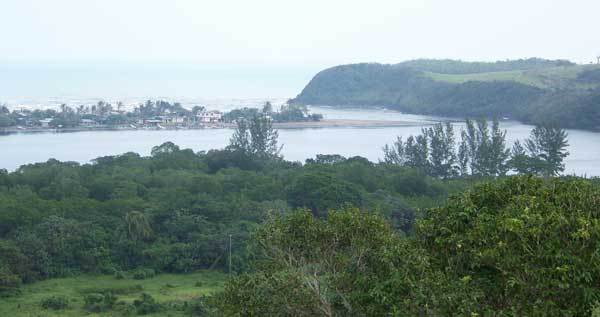
La Barra is a small beach village on a spit of land between Lake Sontecomapan and the Gulf of Mexico. It has a few restaurants, and offers the opportunity to stroll on the beach and pick up seashells. The road to La Barra is reported to be poor, making the lancha ride from the dock at Sontecomapan an attractive and inexpensive alternative, at 25 pesos in each direction. It is a nice boat ride, with views of the lake and the surrounding hills, so worth it for that reason alone. La Barra is the closest beach to Catemaco.
Monte Pio is a small beach village in an area where two rivers empty into the Gulf of Mexico. If you go a little further, past 2 de abril, to Revolution de Abajo, you can ask how to walk to the waterfalls, or perhaps give a child a few pesos to lead you. It is a long way from Catemaco, so if you are just looking for beach, I suggest that you might as well go to La Barra. You can drive in an hour, or take the 1.5 hour pirata ride to Montepio or Revolution de Abajo.
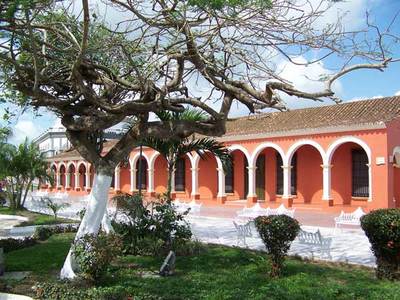
© Richard Ferguson, 2008
Tlalcotalpan is a United Nations World Heritage site, a colorful town on the banks of the massive Papaloapan River. It is roughly halfway between Catemaco and Veracruz. The town is gorgeous, with brightly painted houses, a very nice central plaza, and a relaxed atmosphere. The big festival of the year is for their patroness, the Virgin de Candelaria, Feb. 2nd. The festival lasts several days, and includes processions, music, poetry (décimas), and vendors from hundreds of miles away.
Tlalcotalpan is two hours from Catemaco by car. Tlalcotalpan can be reached by taking a first or second class bus to Alvarado, and then another bus from Alvarado. I was told that it can also be reached using the second class bus between Catemaco and Veracruz, getting off at the turnoff to Tlalcotalpan, and then taking a taxi or local bus the rest of the way.
Santiago Tuxtla has the largest Olmec head found to date, ten feet high (3 m), in the main plaza. The town is tidy and quiet. The municipal museum was pleasant and educational, including a small head, five feet high (1.5m). There were various Olmec artifacts, and several large carved stones, with signs in Spanish. There were also some colonial era items, including inlaid wooden desks and suits of armor.
Tres Zapotes is an Olmec ruin near Santiago Tuxtla. The museum was renovated around 2005, and is very much worth the trip, including an Olmec head, other large carvings, and various artifacts, all with informative signs in Spanish. The Olmec era extended from about 1200 BC to 1200 AD. Unfortunately, the dirt mounds behind the museum lack any signs, and no guides are available. We were the only visitors; they get from 10 to 100 visitors per day. You can get there from Santiago Tuxtla on a collective taxi for 15 pesos, found on the other side of the river from the municipal museum.
Birdwatching is one of the attractions. The region of Los Tuxtlas is known for biodiversity, and for excellent birdwatching. We hired Felix Aguilar to take us birdwatching, near his Ecobiosfera lodge in Dos Amates, on the road between Catemaco and Sontecomapan. We saw many species of birds that we had never seen before. Felix counted almost 50 different species on our morning tour, more than would be typical. Felix says that in the region of Los Tuxtlas, up to 575 different bird species can be seen. Felix’s English is limited, but he has a degree in ornithology, and his knowledge of birds is extensive. Felix also offers other tours, including one to the San Martin Volcano. The phone number of his lodge in Dos Amates is 294 949-7308. Lodging in his rustic cabins is $50 a night.
Nanciyaga is an eco-resort on the bank of Lake Catemaco, with restaurant, rustic cabins, mud bath, and jungle tours. The tour cost 40 pesos, including a walk through the jungle, a visit to the crocodile pen, and an opportunity to pay extra to receive a mud facial, massage, or have a shaman perform a ritual cleansing. On Saturday nights they fire up the temazcal, the ritual steam bath. The tour was available in English. We were lucky enough to see the local howler monkeys swinging through the trees. This is where the movie “Medicine Man”, with Sean Connery, was filmed. You can drive there, take a pirata, or take a boat.
The loop around the San Martin Volcano is a sightseeing tour. If you have a car, and get an early start, you can drive the entire loop in one day, including a few stops. This will include the beach towns of Roca Partida and Monte Pio, as well as the towns of San Andres and Santiago.
Other attractions: Some people enjoy tours of the cigar factories in and around San Andres. One can drive up to Ruiz Cortines, up on the south side of the San Martin Volcano. The summit of the volcano is around 5000 ft (1650 m) above sea level. The University research station, on the east side of the volcano, is on the road to Montepio.
A beautiful place
My wife and I felt that region around Catemaco was one of the most beautiful in all of Mexico, rivaling Chiapas. The people were relaxed and friendly. Sometimes you would turn your head and stop to just admire the view. It is well worth the effort to get there.
Note: This article was based on a trip in January 2008, with the exchange rate 11 pesos to the US dollar.

